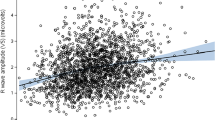Abstract
Looking after children means caring for very small infants up to adult-sized adolescents, with weights ranging from 500 g to more than 100 kg and heights ranging from 25 to more than 200 cm. The available echocardiographic reference data were drawn from a small sample, which did not include preterm infants. Most authors have used body weight or body surface area to predict left ventricular dimensions. The current authors had the impression that body length would be a better surrogate parameter than body weight or body surface area. They analyzed their echocardiographic database retrospectively. The analysis included all available echocardiographic data from 6 June 2001 to 15 December 2011 from their echocardiographic database. The authors included 12,086 of 26,325 subjects documented as patients with normal hearts in their analysis by the examining the pediatric cardiologist. For their analysis, they selected body weight, length, age, and aortic and pulmonary valve diameter in two-dimensional echocardiography and left ventricular dimension in M-mode. They found good correlation between echocardiographic dimensions and body surface area, body weight, and body length. The analysis showed a complex relationship between echocardiographic measurements and body weight and body surface area, whereas body length showed a linear relationship. This makes prediction of echo parameters more reliable. According to this retrospective analysis, body length is a better parameter for evaluating echocardiographic measurements than body weight or body surface area and should therefore be used in daily practice.










Similar content being viewed by others
References
ACC/AHA/ASE (2003) 2003 Guideline Update for the Clinical Application of Echocardiography: Summary Article: A Report of the American College of Cardiology/American Heart Association Task Force on Practice Guidelines (ACC/AHA/ASE Committee to Update the 1997 Guidelines for the Clinical Application of Echocardiography). Committee Members: Cheitlin MD, Armstrong WF, Aurigemma GP, et al. Circulation 108:1146–1162
Du Bois D, Du Bois EF (1916) A formula to estimate the approximate surface area if height and weight be known. Arch Intern Med 17:863–871
Hagendorff A (2008) Transthoracic echocardiography in adult patients: a proposal for documenting a standardized investigation. Ultraschall Med 29:344–374
Henry WL, Ware J, Gardin JM, Hepner SI, McKay J, Weiner M (1978) Echocardiographic measurements in normal subjects: growth-related changes that occur between infancy and early adulthood. Circulation 57:278–285
Henry WL, Gardin JM, Ware JH (1980) Echocardiographic measurements in normal subjects from infancy to old age. Circulation 62:1054–1061
Roge CL, Silvermann NH, Hart PA, Ray RM (1978) Cardiac structure growth pattern determined by echocardiography. Circulation 57:285–290
Silverman NH (1993) Pediatric echocardiography: quantitative methods to enhance morphological information using M-mode, Doppler, and cross-sectional ultrasound. Williams-Wilkins, Baltimore, pp. 35–10 ISBN 0-683-07713-9
Sluysmans T, Colan SD (2005) Theoretical and empirical derivation of cardiovascular allometric relationships in children. J Appl Physiol 99:445–457
Task Force on Blood Pressure Control in Children (1987) Report of the Second Task Force on Blood Pressure Control in Children. Pediatrics 79:1–22
Thomas EL, Fitzpatrick JA, Malik SJ, Taylor-Robinson SD, Bell JD (2013) Whole-body fat: content and distribution. Prog Nucl Magn Reson Spectrosc 73:56–80
Wessel A (1978) Quantitative 2D-Echokardiographie des linken Ventrikels im Kindesalter (quantitave 2d-echocardiography of the left ventricle in childhood). Dr. Kovac 1992, ISBN3-86064-029-1, Hamburg
Wyman WL, Mertens LL, Cohen MS, Geva T (2009) Echoacradiography in pediatric and congenital heart disease: structural measurements and adjustment for growth by Sluysmans T and Colan SD. Wiley-Blackwell, West Sussex, pp. 53–62, ISBN 978-1-4051—7401-5
Author information
Authors and Affiliations
Corresponding author
Appendix
Appendix
From our collected data, we calculated the 3rd, 10th, 25th, 50th, 75th, 90th, and 97th percentiles for the left ventricular end-diastolic, aortic valve, PaV, left ventricular posterior wall, and septal diameters. These were expressed in relation to body length (Figs. 11, 12, 13, 14, 15).
Rights and permissions
About this article
Cite this article
Motz, R., Schumacher, M., Nürnberg, J. et al. Echocardiographic Measurements of Cardiac Dimensions Correlate Better With Body Length Than With Body Weight or Body Surface Area. Pediatr Cardiol 35, 1327–1336 (2014). https://doi.org/10.1007/s00246-014-0932-4
Received:
Accepted:
Published:
Issue Date:
DOI: https://doi.org/10.1007/s00246-014-0932-4









